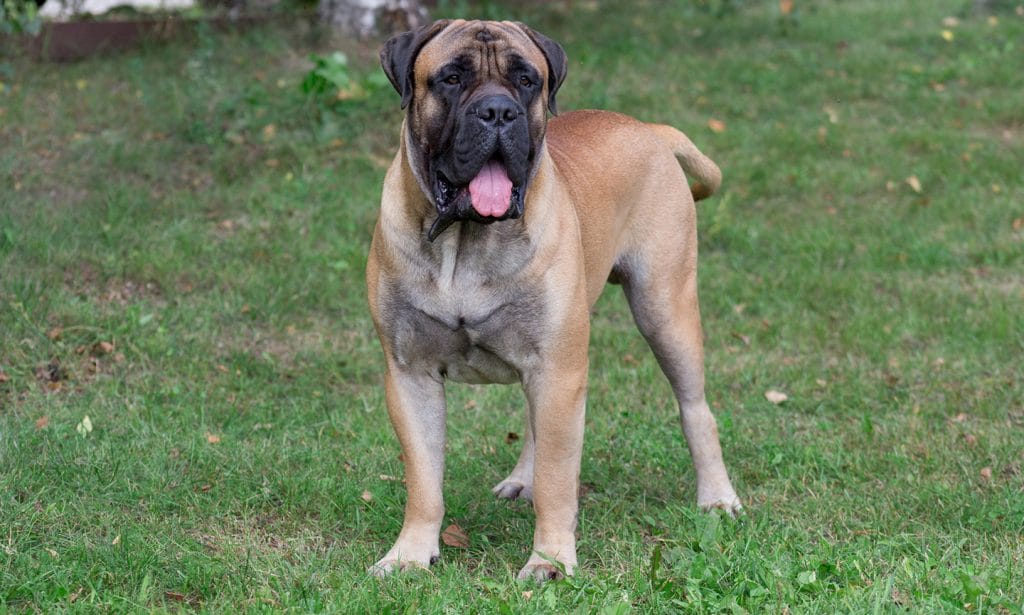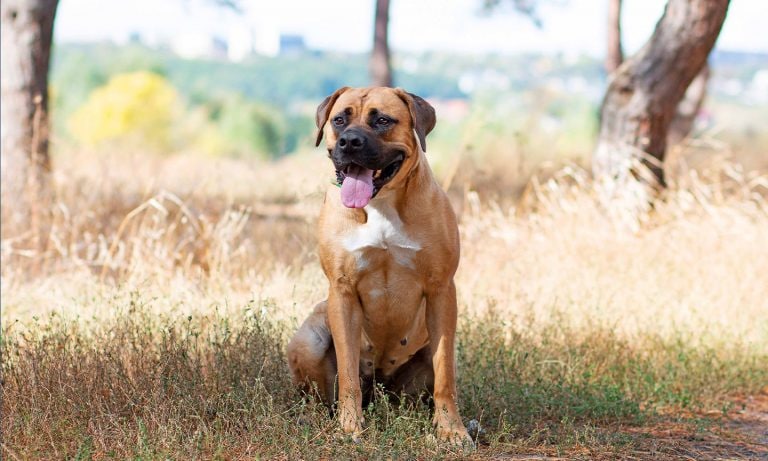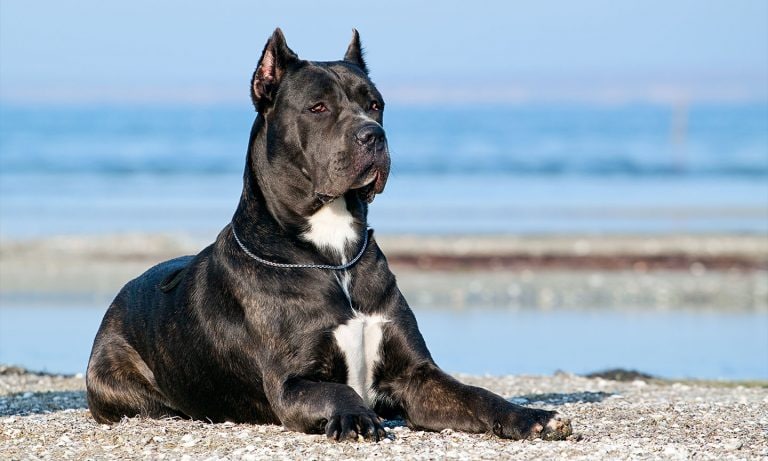Bullmastiffs are the type of guard dog who will patrol your yard and home when you’re gone but will leave their post the minute you walk in the door, because they’re so happy to see you. They won’t shower you with kisses, but you’ll know you’re loved when they lean contentedly against your leg. (Just be sure of your surroundings; they may accidentally knock you over!) And when you sit on the couch to unwind, these gentle giants turn into unexpected lap dogs, folding themselves like a pretzel to fit on your lap. You’ve gotta give them an A for effort!
Breed Snapshot
Temperament:
LovingDevotedCourageousCoat Color:
FawnRedBrindle
Best For
Bullmastiffs, powerful and loyal, thrive on consistent training with their favorite person: you. These devoted and gentle giants are ideal for pet parents with plenty of space and time for training—and plenty of love to give.
Bullmastiff Temperament
Bullmastiffs are affectionate, happy-go-lucky dogs who form deep bonds with their humans and are faithful companions. A cross between the easy-going Old English Mastiff and the courageous Bulldog, the Bullmastiff dog is the perfect combination of their traits.
This big softie isn’t much of a barker. They were bred to spot, track and pin down poachers, and they had to be silent to achieve this mission—truly, they are the ninjas of the dog world. You wouldn’t know they were around, except they’re usually leaning against your leg or trying to fold themselves into your lap. (Wherever you are is their favorite place to be.) And don’t even think of leaving them outside on their own. They’ll be at the back door waiting for you to let them in.
Bullmastiffs are not really aggressive, nor are they known for biting (even though they have a powerful bite force). Like most working breeds, they are confident and self-assured, but can be wary of strangers. So, start training your Bullmastiff puppy early to help get them used to having visitors in your home.
Because they are large dogs who often think they are toy-sized, they can be a bit clumsy around small children, cats and smaller dogs. So, be sure to keep an eye out when your Bullmastiff dog is around anyone smaller than them, and teach children how to interact responsibly with dogs.
How to Care for a Bullmastiff
Bullmastiffs are fairly easy to care for. They have a close-fitting short coat which sheds some year round. You can keep the coat healthy and shiny (and keep the shedding at bay) with regular brushing. They don’t need a lot of exercise, either, but you will need to spend all that free time on training to keep your Bullmastiff well-behaved.
Bullmastiff Health
With a lifespan of 7 to 9 years, Bullmastiffs are prone to a number of health issues. But that shouldn’t stop you from having one as a pet. It’s important for potential pup parents to be aware of these issues, so they can help their pup live a happy, long life.
- Hip and Elbow Dysplasia: Large-breed dogs like the Bullmastiff often suffer from hereditary problems such as hip and elbow dysplasia. This is a condition where the joint doesn’t fit properly. When purchasing a puppy from a breeder, be sure to ask if the parents have been health screened and had their hips and elbows certified by OFA (Orthopedic Foundation for Animals). If you’re adopting your pup, make sure you get a copy of the vet wellness check. These orthopedic issues can often be managed by maintaining a healthy weight, providing regular exercise and, in older dogs, giving joint supplements. In severe cases, surgery may be needed.
- Gastric Dilatation-Volvulus (GDV): GDV (aka bloat) is the sudden and life-threatening condition where the stomach rotates and twists on itself. To help prevent GDV, feed your pup two or three smaller meals throughout the day instead of a large meal and use a slow feeder bowl, which forces your dog to eat only a few pieces of food at a time. Make sure you avoid exercise within an hour of eating, either before or after meals. If you think your pup is suffering from GDV, contact your vet immediately.
- Cancer: Lymphoma and mast cell tumors are the most common cancers affecting Bullmastiffs. Lymphoma is a cancer of the white blood cells that mostly affects the immune system and can most commonly be treated with chemotherapy. Mast cell tumors (MCTs) are a type of skin cancer that often looks like more benign lumps. If you notice any new lumps, contact your vet to get them checked out. MCTs are often treated with radiation.
- Dilated Cardiomyopathy (DCM): DCM is a common heart disease in large breed dogs which can be genetic. The heart is enlarged causing thinning and weakening of the heart muscle. There is a genetic screening test for DCM so be sure to ask your breeder. Treatment is typically daily medication.
- Entropion: In entropion, the eyelids roll inward so that the eyelashes can rub the cornea, creating pain, potentially corneal ulcers, and potentially even blindness. While it can be hereditary, there is no genetic screening test currently available.
Bullmastiff History
The Bullmastiff origins began in mid-to-late 19th-century England when gamekeepers needed a large working dog with the speed to catch poachers. With the Industrial Revolution in full force, people struggling to put food on their tables turned to poaching game, which came with severe punishment. To apprehend the poachers, gamekeepers needed a quiet, quick dog breed. A cross between the fierce Bulldog and the large, good-natured Mastiff resulted in the calm yet formidable guard dog we know as the Bullmastiff.
These dogs were put to work protecting game at night at the expansive country estates and game preserves of the English aristocracy. There, they would keep an eye out for poachers, then quietly pursue and pin them down until the gamekeepers arrived. To double down on their ninja-like skills, gamekeepers preferred brindle dogs (subtle tiger stripes), so the dog would be perfectly camouflaged at night.
Soon, gamekeepers began to argue over who had the most-prized Bullmastiff, leading to competitions and exhibitions of the best dogs; quickly, the canine became a popular show dog. Around the same time, the breed became so well-known as a guard dog they were used to guard the De Beers diamond mines in South Africa (around the late 1920s). In 1933, the Bullmastiff was recognized as a breed by the American Kennel Club.
So, where is the best place to find Bullmastiff puppies today? You can find a list of reputable breeders on the American Kennel Club’s website. What’s the average Bullmastiff price? Expect to spend anywhere from $2,000 to $3,000 for a pup. But for that, you’ll likely get a puppy who’s been screened for health issues and may come with pedigree papers. You can also reach out to Mastiff rescue organizations (either local or through The American Bullmastiff Association) to adopt a Bullmastiff, keep a look out for the breed at your local animal shelter, or search Chewy’s database of adoptable dogs in your area.
FAQs
Are Bullmastiffs hypoallergenic?
No, Bullmastiffs are not hypoallergenic. Even though they have short coats, Bullmastiffs shed moderately and often drool, which can trigger allergies.
Do Bullmastiffs drool?
Yes, Bullmastiffs drool, so you may want to designate a towel that’s specifically theirs. Bullmastiffs drool because they have loose lips (but they’ll take your secrets to the grave).
Are Bullmastiffs good guard dogs?
Bullmastiffs were originally bred to serve as guard dogs, and can be trained as guard dogs today, too. But remember, they are as quiet as ninjas, not barkers.
What are the most popular Bullmastiff names?
Popular Bullmastiff names include Bear, Champion, Braveheart, King, Knight, Gallant, Spirit, Clifford, Bruiser, Goliath, Maximus, Jupiter and Rocky. Get more dog names here.
What are the most common Bullmastiff mixes?
The most common Bullmastiff mixes are:
- Bullmastiff-Pit mix (Pit Bull Mastiff)
- Bullmastiff-Great Dane mix (Bull Daniff)
- Bullmastiff-Boxer mix (Boxmas)
- Bullmastiff-German Shepherd mix (German Shedders)
- Bullmastiff-Rottweiler mix (Bull Mastweiler)
Note: These are not purebred dogs but mixed breeds.

Top Takeaways
Bullmastiffs are extremely loyal, smart and dedicated family companions. They love nothing more than being with their people, as a shadow and a guardian. Sure, they are massive dogs who need training, but it’s an easy trade-off to have a doting and loving dog. Raising a Bullmastiff is extremely rewarding, and these dogs make great companions for experienced pet parents who have the time to dedicate to their furry family member.
Expert input provided by Rachel Barrack, DVM, CVA, CVCH and owner of concierge practice Animal Acupuncture in New York City; Jennifer Frione, DVM and owner of Lakeside Animal Hospital in Plantation, Fla.; Jay Rowan VMD, Co-Owner of Paoli Vetcare, an AAHA-accredited small animal hospital in the Philadelphia metro area; and Laurie C. Williams CPDT-KA CDTI, owner/training director of Pup ‘N Iron Canine Fitness & Learning Center in Fredericksburg, Va.
Breed characteristic ratings provided by veterinarian Dr. Sarah J. Wooten, DVM, CVJ, a veterinarian at Sheep Draw Veterinary Hospital in Greeley, Colorado; dog trainer and behavior consultant Irith Bloom, CPDT-KSA, CBCC-KA, CDBC, owner of The Sophisticated Dog, LLC, in Los Angeles; and certified animal behavior consultant Amy Shojai, CABC, in Sherman, Texas.
The health content was medically reviewed by Chewy vets.

Search for Adoptable Bullmastiffs Near You
Female Names
- Bella
- Luna
- Nala
- Lucy
- Ruby
- Maggie
- Nova
- Harley
- Remi
- Willow
Male Names
- Duke
- Zeus
- Max
- Tank
- Bear
- Brutus
- King
- Thor
- Bruno
- Hank
Share:




























